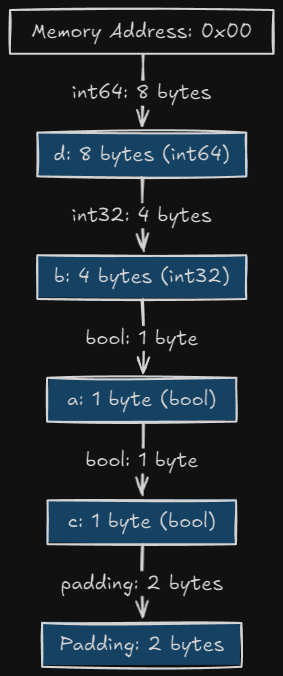
Greetings, Gophers! During the initial year of working with Golang, I kept thinking that there must be ordering of fields and I thought why should I be bothered about it? Well, it is only fields, only something wrong could it be, I right? As most of the other novices, I thought it was not worth bothering with. In other words, how vital could it be that certain fields in a struct, would be put in a specific order? Well, a great deal!
Field ordering is one of the aspects ignored at the beginning but as one proceeds with the tutorial this understanding particularly of how Go works with pointers is understood as being very critical. Actually, it is precisely this order that is critical when it comes to improving application performance especially when working with large data sets or operations that are too heavy on memory. That unfortunate deficiency will be mended in a better understanding why it is so critical with Go field ordering.
When placed in memory, structs are represented as a block of consecutive memory, in which all the fields are located one after another according to their definition in a structure. This might seem rather simple, but this kind of linear organization plays some quite significant effects too, particularly in areas such as memory alignment and padding.
Memory alignment is about how data is placed and accessed from memory. Normally, CPUS can have a bias in terms of where data is fetched in memory, which is referred to as alignment boundaries. For instance, a 32 bit integer should be placed or fetched from the 4th byte address. In cases where there are fields in your struct which are not aligned properly, flicking through the pages, a Go compiler may add padding bytes, and so on. This becomes quite wasteful. For example, look at this struct.
struct example{
a bool // 1 byte
b int32 // 4bytes;
c bool // 1byte
d int64 //8 bytes
}

In this improper struct because of alignment rules, the Go compiler might add one or more padding bytes in middle of these fields:
a is 1 byte but b wants 4 bytes align hence padding is inserted 3bytes
b length is of 4bytes
c length is of 1 byte but to align d which requires 8 bytes there is 7asing hence padding is introduced.
d length is of 8 bytes
How wood be structural wood, still is 24 in size because of the legs though the content only takes 14 however look at the volume of the actual content plus that of the padding.
Field order and structure finding can help to avoid wasting space in the form of negative margin. In another words:
type Example struct {
d int64 // 8 bytes
b int32 // 4 bytes
a bool // 1 byte
c bool // 1 byte
}

In the above optimized struct:
d occupies 8 bytes.
b occupies 4 bytes.
a and c occupies 1 byte each without the need of the padding.
This structure is now only 16 bytes in size and this is better than the former 24 byte sized structure.
As one considers common small-scale applications, he or she will most probably find the amount of memory in use by the application to be no different from the latter. This however is not the case in construction where performance and even memory space are critical consider a system embedded, super fast high frequency trading applications, or applications meant to process tremendous bulk of data these faithful restraint can add up fast. This becomes even more evident when one constructs or operates using many large arrays or concatenated slices of structs. It is not as easy to notice bias or load union when a structure has only a” s few bytes higher capacity. When low memory architecture is mass produced, with the amount of millions of instances to be handled, little by little, this addicted overdose of waste is no longer unheard of.
La commande des champs n'est pas seulement intéressante du point de vue de la conception des structures Golang, mais joue également un rôle important dans l'optimisation de la mémoire. Comprendre cet aspect de la façon dont Go organise la disposition de la mémoire pour vos structures et leurs pixels permet une conception de structures plus efficace dans la pratique. Un ajustement aussi insignifiant peut entraîner une amélioration considérable des performances lorsqu'il s'agit d'applications qui utilisent beaucoup de mémoire. Lorsque la prochaine opportunité se présentera pour vous de définir une structure dans Go, ne vous contentez pas de disperser ces champs. Au lieu de cela, consacrez une minute à réfléchir à la séquence - vous en serez reconnaissant envers vous-même et votre candidature dans les jours à venir !
Ce qui précède est le contenu détaillé de. pour plus d'informations, suivez d'autres articles connexes sur le site Web de PHP en chinois!
 La différence entre vue2.0 et 3.0
La différence entre vue2.0 et 3.0
 Comment utiliser la fonction mid
Comment utiliser la fonction mid
 Somme de cellule
Somme de cellule
 Quelles sont les utilisations de winlicense ?
Quelles sont les utilisations de winlicense ?
 Que signifie le jumeau numérique ?
Que signifie le jumeau numérique ?
 Utilisation de la suppression de base de données
Utilisation de la suppression de base de données
 Les photos Windows ne peuvent pas être affichées
Les photos Windows ne peuvent pas être affichées
 Comment configurer les variables d'environnement JDK
Comment configurer les variables d'environnement JDK